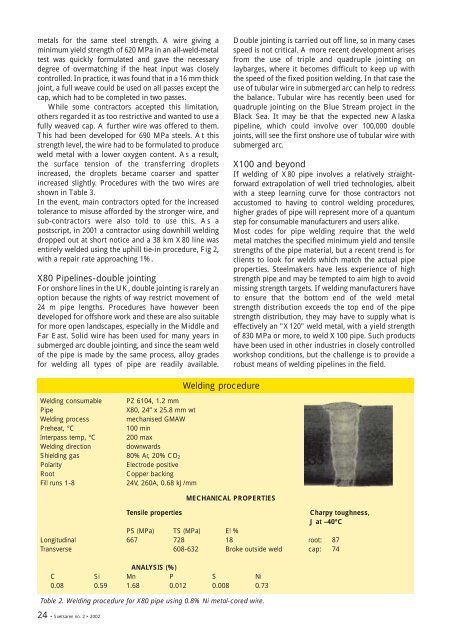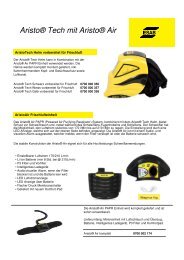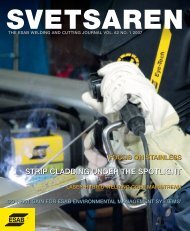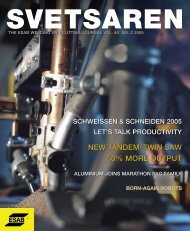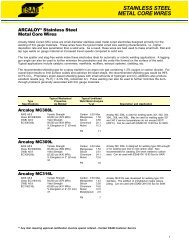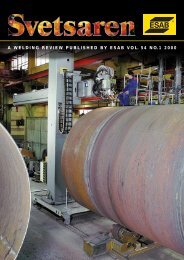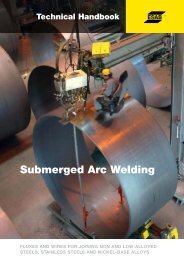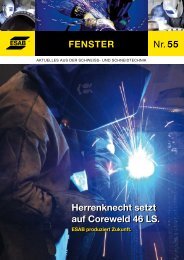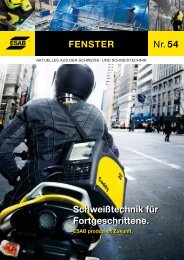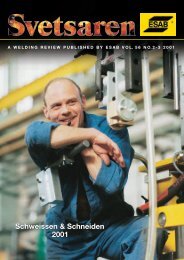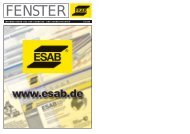Svetsaren_nr2 definitief (Page 1) - Esab
Svetsaren_nr2 definitief (Page 1) - Esab
Svetsaren_nr2 definitief (Page 1) - Esab
You also want an ePaper? Increase the reach of your titles
YUMPU automatically turns print PDFs into web optimized ePapers that Google loves.
metals for the same steel strength. A wire giving a<br />
minimum yield strength of 620 MPa in an all-weld-metal<br />
test was quickly formulated and gave the necessary<br />
degree of overmatching if the heat input was closely<br />
controlled. In practice, it was found that in a 16 mm thick<br />
joint, a full weave could be used on all passes except the<br />
cap, which had to be completed in two passes.<br />
While some contractors accepted this limitation,<br />
others regarded it as too restrictive and wanted to use a<br />
fully weaved cap. A further wire was offered to them.<br />
This had been developed for 690 MPa steels. At this<br />
strength level, the wire had to be formulated to produce<br />
weld metal with a lower oxygen content. As a result,<br />
the surface tension of the transferring droplets<br />
increased, the droplets became coarser and spatter<br />
increased slightly. Procedures with the two wires are<br />
shown in Table 3.<br />
In the event, main contractors opted for the increased<br />
tolerance to misuse afforded by the stronger wire, and<br />
sub-contractors were also told to use this. As a<br />
postscript, in 2001 a contractor using downhill welding<br />
dropped out at short notice and a 38 km X80 line was<br />
entirely welded using the uphill tie-in procedure, Fig 2,<br />
with a repair rate approaching 1%.<br />
X80 Pipelines-double jointing<br />
For onshore lines in the UK, double jointing is rarely an<br />
option because the rights of way restrict movement of<br />
24 m pipe lengths. Procedures have however been<br />
developed for offshore work and these are also suitable<br />
for more open landscapes, especially in the Middle and<br />
Far East. Solid wire has been used for many years in<br />
submerged arc double jointing, and since the seam weld<br />
of the pipe is made by the same process, alloy grades<br />
for welding all types of pipe are readily available.<br />
Double jointing is carried out off line, so in many cases<br />
speed is not critical. A more recent development arises<br />
from the use of triple and quadruple jointing on<br />
laybarges, where it becomes difficult to keep up with<br />
the speed of the fixed position welding. In that case the<br />
use of tubular wire in submerged arc can help to redress<br />
the balance. Tubular wire has recently been used for<br />
quadruple jointing on the Blue Stream project in the<br />
Black Sea. It may be that the expected new Alaska<br />
pipeline, which could involve over 100,000 double<br />
joints, will see the first onshore use of tubular wire with<br />
submerged arc.<br />
X100 and beyond<br />
If welding of X80 pipe involves a relatively straightforward<br />
extrapolation of well tried technologies, albeit<br />
with a steep learning curve for those contractors not<br />
accustomed to having to control welding procedures,<br />
higher grades of pipe will represent more of a quantum<br />
step for consumable manufacturers and users alike.<br />
Most codes for pipe welding require that the weld<br />
metal matches the specified minimum yield and tensile<br />
strengths of the pipe material, but a recent trend is for<br />
clients to look for welds which match the actual pipe<br />
properties. Steelmakers have less experience of high<br />
strength pipe and may be tempted to aim high to avoid<br />
missing strength targets. If welding manufacturers have<br />
to ensure that the bottom end of the weld metal<br />
strength distribution exceeds the top end of the pipe<br />
strength distribution, they may have to supply what is<br />
effectively an "X120" weld metal, with a yield strength<br />
of 830 MPa or more, to weld X100 pipe. Such products<br />
have been used in other industries in closely controlled<br />
workshop conditions, but the challenge is to provide a<br />
robust means of welding pipelines in the field.<br />
Welding consumable PZ 6104, 1.2 mm<br />
Pipe<br />
X80, 24” x 25.8 mm wt<br />
Welding process<br />
mechanised GMAW<br />
Preheat, °C<br />
100 min<br />
Interpass temp, °C 200 max<br />
Welding direction<br />
downwards<br />
Shielding gas 80% Ar, 20% CO 2<br />
Polarity<br />
Electrode positive<br />
Root<br />
Copper backing<br />
Fill runs 1-8<br />
24V, 260A, 0.68 kJ/mm<br />
Welding procedure<br />
MECHANICAL PROPERTIES<br />
Tensile properties<br />
Charpy toughness,<br />
J at –40°C<br />
PS (MPa) TS (MPa) El %<br />
Longitudinal 667 728 18 root: 87<br />
Transverse 608-632 Broke outside weld cap: 74<br />
ANALYSIS (%)<br />
C Si Mn P S Ni<br />
0.08 0.59 1.68 0.012 0.008 0.73<br />
Table 2. Welding procedure for X80 pipe using 0.8% Ni metal-cored wire.<br />
24 • <strong>Svetsaren</strong> no. 2 • 2002


